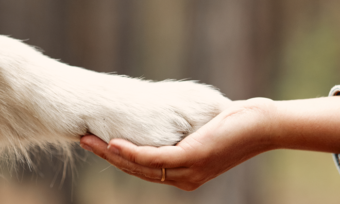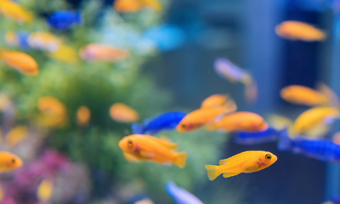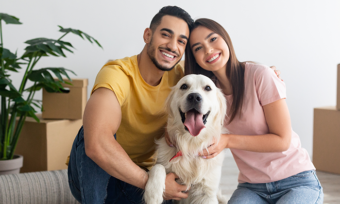
Why is my dog peeing inside?
Dogs urinating inside when they shouldn’t can be a bit of a puzzle sometimes – especially when they’re no longer puppies. There are several common reasons why they might do it:
Lack of training
First of all you, you need to understand why your dog is peeing inside. If they’ve been doing it since they were a puppy, then maybe you need to be thinking about the lack of training. This would be a really good area to work on before you worry about anything else.
It takes time and patience to house train a dog, but it’s definitely possible. Be consistent with your training, and be sure to reward your dog for going outside to pee.
→Related article: 7 Pet Parenting Mistakes to Avoid
Illness
However, if it’s a new problem then, perhaps, it’s caused by disease or illness. There might be a bladder infection, it might be incontinence, or there may be some other disease that’s causing a huge amount of thirst. This would include things like diabetes or Cushing’s Disease.
If it’s a disease, there are other things you may have noticed as well.
There may be behavioral changes, such as increased drinking, or your dog, who used to be able to go through the night without peeing, now can’t. These are indicators that can help you determine whether an underlying disease or illness might be the issue. In such cases, it’s advisable to schedule a vet visit and consult with your veterinarian.
Anxiety
Anxiety can also be a cause of dogs urinating, and it can manifest in various ways.
We’ve all likely encountered a dog that becomes excessively excited, especially puppies, and ends up urinating during greetings.
When a dog is feeling anxious or stressed, they may urinate indoors as a coping mechanism. This can be triggered by factors such as changes in the household, thunderstorms, or loud noises. If you suspect that your dog is anxious or stressed, try to identify the source of their anxiety and address it if possible.
You can also focus on behavioral training to teach your dog to have calm greetings. Additionally, creating a safe space where they can retreat to when feeling insecure may prove helpful.
→Related article: Tips for Puppy Training

Boredom
With some dogs, boredom might be the cause.
Dogs require mental stimulation and exercise as much as they need physical activity. If your dog is bored, they may start exhibiting undesirable behaviors, such as urinating indoors. Ensure that your dog has plenty of activities to engage in, such as toys to play with, regular walks, and training sessions.
Territorial dominance
This behaviour is more common in unneutered male dogs, but it can also occur in female dogs. Marking is a way for dogs to communicate with each other, and it can be triggered by factors such as the introduction of new pets or people into the household or changes in the environment.
If this is a new behavior that has developed with the arrival of a new family member, whether it’s another pet or a human, in some cases, your dog may perceive it as a threat within the house.
Lacking outside time
Dogs need to urinate regularly, so if they’re not getting enough chances to go outside, they might start going inside. Ensure that you take your dog out to pee at least every 3-4 hours, and more frequently if they are young, old, or have a medical condition.
How can I stop my dog peeing inside?
Once you’ve established that your dog isn’t urinating inside the house for medical reasons, you can focus on positive reinforcement training and other measures.
Stopping your dog from peeing inside the house is a common challenge, but with patience and consistency you can help them learn where it’s appropriate to go. Here are some steps to help you achieve that:
1. Establish a routine
Dogs thrive on routines. Take your pup out at the same times every day, especially after meals, when they wake up, and before bedtime. This helps them understand when it’s time to go outside.
Consistency is key in dog training. Stick to your routine and reinforce positive behaviour. It might take some time, but your dog will learn!
2. Use positive reinforcement
When your dog pees outside, praise and reward them with treats or affection. Positive reinforcement reinforces the idea that peeing outside is a good thing. Don’t scold or punish your dog for urinating inside, as this can make your dog fearful and anxious. They may associate urination with your anger, which can lead to stress and anxiety, making the problem worse.
On top of that, dogs live in the present moment, so if you scold them for something they did earlier, they might not connect the punishment to the action. This can lead to confusion and won’t help them understand the right behaviour.
3. Watch for signs
Pay attention to your dog’s cues. Sniffing, circling, or whining can be signs they need to go out. Quickly take them outside when you notice these behaviours.

4. Create pee-free zones
If your dog is having accidents, don’t give them free rein of the house. Use baby gates or a crate when you can’t supervise them closely. This prevents accidents and gives them fewer opportunities to pee inside.
5. Clean well
When accidents happen it’s a good idea to clean any indoor messes with an enzymatic cleaner. This helps eliminate the smell that can attract your dog to pee in the same spot again.
6. Be patient
Understand that accidents are part of the learning process. As mentioned, don’t scold or punish your dog for accidents inside the house.
7. Neuter or spay your dog
This means having a simple surgery to prevent your dog from reproducing. It’s not just about birth control; it can help with their indoor peeing, too.
Here’s how it helps:
- Less territory marking: it can calm down that urge to mark their territory with pee. That’s a big win for preventing indoor accidents
- Better behaviour: you’ll often notice an improvement in your dog’s behaviour after the procedure. They might become more focused and easier to train
- Population control: it’s a responsible way to control the number of puppies out there, which is a good thing for the doggy world
8. Consider professional help
If you think you need help then seek it from your vet or consider contacting an accredited behaviourist.
A pet behaviourist can be a real lifesaver when you’re dealing with tricky pet problems. Here’s how they can lend a helping hand:
- Understanding your pet’s mind: these experts are like pet psychologists. They get inside your pet’s head to understand why they’re acting the way they are, whether it’s chewing furniture, being aggressive, or peeing indoors
- Custom solutions: once they figure out the root cause, they’ll create a tailored plan to fix the issue. No one-size-fits-all here; it’s all about what works best for your dog
- Training tips: animal behaviourists are like personal trainers for your pets. They’ll teach you effective training techniques to reinforce good behaviour and eliminate your dog urinating inside
- Communication: sometimes, our pets have trouble communicating their needs or emotions. Behaviourists can help you understand what your pet is trying to tell you, so you can respond appropriately
- Peace in the home: by working with an animal behaviourist, you can bring peace and harmony back to your home. No more torn-up couches, constant barking or pee where it shouldn’t be
Compare pet insurance providers here!
About the reviewer of this page
This report was reviewed by Canstar Content Producer, Caitlin Bingham. Caitlin is an experienced writer whose passion for creativity led her to study communication and journalism. She began her career freelancing as a content writer, before joining the Canstar team.
Enjoy reading this article?
You can like us on Facebook and get social, or sign up to receive more news like this straight to your inbox.
By subscribing you agree to the Canstar Privacy Policy





Share this article